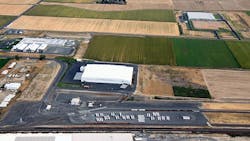Port of Quincy seeks funds for its intermodal terminal
The Port of Quincy WA is requesting $16.2 million in transportation funding from the Washington State Legislature to expand infrastructure at its intermodal terminal to help restore critical domestic eastbound intermodal rail service for perishable and frozen foods shippers of central Washington fresh produce.
The Port of Quincy Intermodal Terminal Infrastructure Expansion Project has received widespread support with dozens of shippers and organizations sending letters to the Washington State Legislature in support of the request. Additionally, the Great Northern Corridor Coalition, an organization formed to promote shared regional cooperation, planning, and project implementation to improve rail freight movement across the Great Northern Corridor, has also included the Port of Quincy project on its list.
This intermodal terminal is in central Washington on a key cross-country rail mainline (Seattle-Chicago Northern Corridor BNSF mainline) near Interstate 90 in the heart of one of the largest irrigated agricultural and food processing regions in North America. In 2011, Burlington Northern Santa Fe (BNSF) Railway designated Quincy WA as an official intermodal terminal on its national intermodal map. The Port of Quincy Intermodal Terminal has been a key hub for shipping Washington state frozen foods and fresh produce to destinations throughout the US Midwest and East Coast. According to a recent study of 29 western US and Canadian locations with intermodal connections to regional markets, Quincy ranked as the lowest-cost location for operating a distribution center or a warehouse.
The project would expand infrastructure at the Port of Quincy Intermodal Terminal to meet unit train requirements of BNSF and help eliminate congestion on the Great Northern Corridor Rail Line at Quincy. It would include installation of three more intermodal tracks to increase capacity of the terminal to simultaneously load or unload longer intermodal container trains; and a new longer siding track and set out/pick-up track that would allow longer trains to pull off of the BNSF mainline at Quincy for arrival and departure in one piece. The project would entail expanding the surface area of the intermodal terminal to allow for more storage of containers, and constructing a bridge across the US Bureau of Reclamation West Canal near Quincy.
Expanding infrastructure of the terminal will then allow the Port of Quincy to bring in an intermodal operator to begin shipping Washington state fresh produce, frozen foods, and other perishable goods again. With continuing tightening in long-haul truck and railcar supplies, expanding the terminal and restoring intermodal service at Quincy will provide central Washington perishable shippers with competitive and much-needed shipping capacity to ship Washington state products to Midwestern and eastern US markets.
For more information, access www.portofquincy.org.
